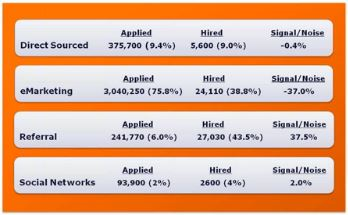 If you're spending 80 to 90% of your time and resources finding candidates on LinkedIn, then you're probably going to say that you get most of your hires from LinkedIn. This isn't necessarily a bad thing, but it does mean that your data is biased because you spend most of your time on LinkedIn sourcing candidates. Where else are you supposed to find candidates if you're spending that much time and energy on one source?
If you're spending 80 to 90% of your time and resources finding candidates on LinkedIn, then you're probably going to say that you get most of your hires from LinkedIn. This isn't necessarily a bad thing, but it does mean that your data is biased because you spend most of your time on LinkedIn sourcing candidates. Where else are you supposed to find candidates if you're spending that much time and energy on one source?
As stated, this isn't necessarily bad, but it might not be the best expenditure of your time and resources. To find the best source, or sources, for your organization, it's recommended that you start measuring your signal to noise ratio.
What is the Signal to Noise Metric
"Signal to Noise measures the difference between where candidates came from to apply for your position and those that led to an in-person interview, led to an offer, and ultimately led to a hire." said Ray Rike, chief operating officer at Accolo. "[This] is going to impact where you decide to market your jobs, and it's also going to bias your data as to where those hires are coming from."
The Signal to Noise Metric
Here is what the signal to noise metric looks like, how it works, and how it biases where you put your resources to find those candidates and to make those hires. The larger the percentage, the better the ratio, so it's with those larger percentages that you really want to be spending your time and resources:

It should be noted that the percentages refer to either the percentage of those that applied or the percentage of those that were hired. For example, direct sourcing constituted 9.4% of those who applied and 9% of those who were hired. If 1000 people applied, then 9.4% of them came from direct sourcing. If 100 people were hired, then 9% of those who were hired came from direct sourcing. It's not that 9% of those who applied via direct sourcing were hired.
Rike suggests that you shouldn't ignore direct sourcing or job boards, even though the signal to noise ratios may not be as high. The ratios simply mean that if you use job boards, for example, you will have to do more to sort through the noise and the passive candidates to find those good hires. However, it does mean that you might have to do more screening or to cut back on the number of job boards you are using to find candidates.
"We use every potential outlet because we don't believe that a job board is necessarily just where you'll find a candidate," Rike said. "It's where you may find the perfect referral source for the best candidate."
Social Media Recruiting Isn't Everything (Yet)
According to the data, social media is a good source for candidates, but it can't be relied upon to fill every open position. This is because it's only constituting a small percentage of those who apply and those who are hired, and although the signal to noise ratio is good, social media isn't that strong of a pipeline. Instead, social media should be viewed primarily as another referral source.
"Anyone who is saying, 'I'm only going to rely upon one primary source of great candidates for sourcing and for applying to jobs,' is eliminating themselves from over 90% of potential great hires," Rike said.
Want to learn more about candidate sourcing, and which tactics really work in finding the best candidates? View this webinar:
"Amazing Charts & Stats About Candidate Sources for 2013."
The 60-minute webinar features interesting hiring stats about job board performance including CareerBuilder, Craig's List, DICE, Indeed, Job Central, (The) Ladders, Monster, Simply Hired as well as compelling hiring stats about social networks including LinkedIn, Facebook, and Twitter. Acccess webinar.
Related Links:
3 Tips to Improving the Candidate Experience















